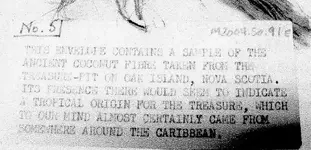According to the sample on display at the Maritime Museum of the Atlantic which were taken from the money pit area the coconut fibers are from the Caribbean area.
View attachment 1715787
Did they DNA test those fibers? If not, they may be talking out of their rear ends. (As they did when they mentioned where the treasure must have come from, as no treasure is known to have been recovered. One can't know where a treasure came from if nobody has found it yet and proved that it exists. I would think that this is obvious, but welcome to the Oak Island forum, where we do things a little differently.)
So the Coconut Fibers had to be transported there from the Mediterranean Sea or from the Orient.
If they were from Indian coconuts, sure. If those fibers came from SE Asian coconuts, then the question is more complicated.
If they were from Indian coconuts, that doesn't tell us how they got there. That tells us where they came from. Carbon dating doesn't tell us when they got there. It tells us the earliest date at which they could have got there.
Since no one else was suppose to be over in America before CC in 1492 how did the Coconut Fibers get over here almost 200 years before CC?
It's already an established fact that Europeans had made it to the New World ~500 years before Columbus. This is from real history books, not the "Templars winning wars for the Scots" history books that I'm still waiting for.
But it's an interesting question with no clear answer. We can speculate about that all that we'd like to, and this is fine...just so long as we admit that we're speculating.
I often mention the idea of Icelanders taking coconuts to the New World. I don't personally believe that, but it's a theory that has more circumstantial evidence backing it up than the Templar theory does. Unfortunately for the Icelanders, no popular works of fiction have worked this into their plots. That's exactly why I throw it out there.




